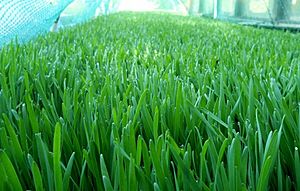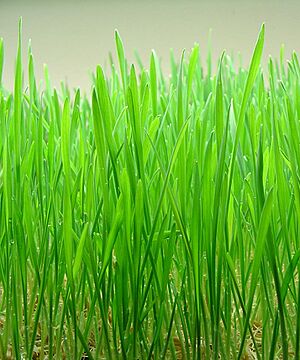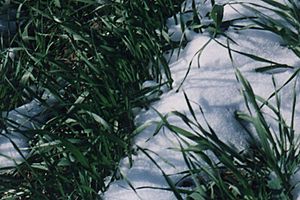Wheatgrass facts for kids

Wheatgrass is the very first leaves that sprout from a common wheat plant. Its scientific name is Triticum aestivum. People use wheatgrass as a food, a drink, or a special supplement to their diet. You can find wheatgrass fresh or freeze-dried. This is different from wheat malt, which is dried using heat. Wheatgrass is allowed to grow taller than wheat malt.
Like most plants, wheatgrass contains chlorophyll, which gives it its green color. It also has amino acids (the building blocks of protein), minerals, vitamins, and enzymes. Some people believe wheatgrass offers many health benefits, from giving extra nutrition to helping with illnesses. However, these ideas have not been fully proven by science.
Wheatgrass juice is often sold at places that make fresh juices. Some people even grow wheatgrass and make juice at home! You can buy wheatgrass fresh, as tablets, frozen juice, or powder. It is also sold in other forms like sprays, creams, gels, or as a liquid herbal supplement. Wheatgrass juice comes from the young wheatgrass sprouts before the wheat seed (called a "berry") forms. This means wheatgrass juice is naturally gluten-free. However, some experts suggest that people with celiac disease should be careful. This is because there's a small chance of cross-contamination if it's prepared near other wheat products.
History of Wheatgrass Use
Wheatgrass has been used for a long time in some cultures. In Persia and India, it is part of traditional festivals and rituals. For example, during the Hindu festival of Navaratri, people plant wheat or barley seeds. On the last day, they offer the young plants to a mother goddess as part of their worship.
In the Western world, people started using wheatgrass more in the 1930s. This happened because of experiments by Charles Schnabel. He worked to make the plant more popular. By 1940, you could buy Schnabel's powdered grass in many drug stores across the United States and Canada.
Ann Wigmore was another person who strongly supported eating wheatgrass. She believed it was an important part of a raw food diet. Wigmore started the Hippocrates Health Institute. She thought that wheatgrass, as part of a raw food diet, could help cleanse the body and provide good nutrients. She also taught that wheatgrass could help people with serious health problems. Many health organizations today say that these claims are not supported by facts.
Growing Wheatgrass
You can grow wheatgrass either indoors or outdoors. A common way to grow it inside is on trays using a special soil mix. The leaves are ready to be picked when a new leaf starts to grow, making a "split" in the older leaf. You can cut these leaves with scissors. Often, a second set of shoots will grow from the same plant. Sometimes, you can even get a third cutting, but these leaves might be tougher and less sweet than the first ones.
Charles Schnabel did his research using wheatgrass grown outdoors in Kansas. His wheatgrass grew slowly for about 200 days through the winter and early spring. He harvested it when the plant reached a certain stage of growth. Schnabel said that at this point, the plant had the most nutrients. After this stage, the amount of chlorophyll, protein, and vitamins in the plant would drop quickly. Wheatgrass is harvested, freeze-dried, and then sold as tablets or powders for both people and animals. Wheatgrass grown indoors is often used to make wheatgrass juice powder.
See also
 In Spanish: Pasto de trigo para niños
In Spanish: Pasto de trigo para niños



